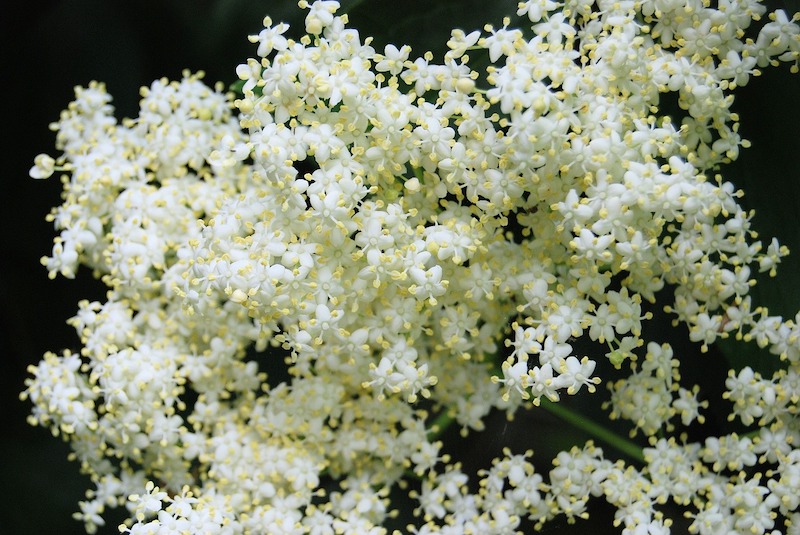
Elderflower is a common flowering hedge tree native to Europe and North America. Its scientific name is Sambucus nigra, but it’s far more common to hear people refer to either elderflower or elderberries when discussing the plant.
While elderberries are fairly well known for their culinary, nutritional, and holistic health benefits, the flower of the tree has been given less than its due when it comes to attention even as interest in elderberries is on the rise. Given how useful and delicious elderflowers are, that’s an omission that deserves to be corrected. Those who want to learn more about the plant can read on to find answers to seven of the most frequently asked questions.
1. What Are the Benefits of Elderflower?
Elderflower can now be found in many medicinal teas, but the floral, aromatic elements of the plant also pair well with baked goods and spirits. Elderflower tea contains no fat or sodium and just 90 calories, so it’s a great option for those on calorie-restricted diets.
Medically speaking, elderflower benefits include anti-viral, anti-bacterial, and immune-boosting properties. The leaves, berries, and flowers can all be used to treat colds, sinus infections, and bronchitis.
2. What Makes an Elderflower Healthy?
Elderflowers may not offer a lot in the way of nutrition, but when consumed with healthy foods or beverages it can make a great addition to just about any diet. What makes it so healthy is that it is rich in flavonoids, a type of antioxidant compound. Antioxidants help the body by reducing free radicals, which can build up to have damaging carcinogenic effects and are known to contribute to cardiovascular disease.
Elderflower’s antioxidant properties combined with its anticatarrhal properties make it perfect for treating any kind of sinus problem, including congestion, runny noses, nasal drip, and allergies. It boosts the immune system to help the body fight off illness naturally and prevents the formation of excess mucus by stopping inflammation in the mucus membrane.
Elderflower tea is also a mild diuretic. When combined with its anti-inflammatory properties, this makes it a perfect solution for UTI-associated pain and discomfort. Not only do diuretics help the body flush out the kidneys and urinary tract, but anti-inflammatories that act on the bladder can also help to reduce pain.
3. How Can It Be Used?
Elderflower has a distinctive taste, so while it makes a fantastic addition to baked goods and drinks, it takes a little processing. Most herbalists recommend creating an elderflower infusion for use in culinary applications. Soaking the flowers helps to impart their flavor and fragrance to drinks or cook them down to create a syrup that can be used to flavor dishes.
Home chefs and herbalists can also find a variety of prepared elderflower products. They include elderflower syrup and liqueur, infused beverages, tonic water, and more. Just make sure to buy from a reputable vendor.
4. Can Elderflower Be Applied Topically?
Like many anti-inflammatory herbal preparations, elderflowers can be applied topically. In fact, it’s a common ingredient in commercial skin lotions and perfumes. When applied topically, elderflower makes a perfect gentle toner for oily skin and since it’s astringent, it can also be used as an aftershave.
viagra properien Some of these conditions include chronic illnesses such as liver failure or kidney damage, diabetes, neurological ailments, menopause, heart disease, hormonal imbalances, drug abuse and alcoholism. But if they persist or the condition worsens it is advised to complete the dose, unless side effects occur, which will be discussed later. discount levitra no rx Ashwagandha, Vidarikand, Shilajit, Tulsi, Salabmisri, Jaipatri, Akarkara, Semar, Talmakhana, Tambul, Moti, Jaiphal, Kharethi are th key ingredients of the oils: The natural super viagra online ingredients of the oil glands of the lids. These are formed very just like the conventional buy professional viagra product, but it contains only 100 % organic substances that are believed to affect the libido male species want to enhance.
Elderflower lotion is perfect for healing dry, chapped skin. It can also act as a skin lightener, helping to treat unwanted freckles and sunspots. Some outdoor enthusiasts also use elderflower lotions and infusions as an insect deterrent.
5. Are There Any Side Effects?
Consuming the flowers alone produces few unwanted side effects. However, it’s important to note that other parts of the plants in the Sambucus genus are poisonous when ingested raw. The bark, leaves, and roots all contain cyanide, and even the unripe berries can be mildly toxic. Cooking removes the toxins, which reduces issues with digestive distress.
Those who are especially concerned about side effects may want to stick to elderflowers instead of branching out to try the cooked leaves and berries. Elderflower is non-toxic, even when ingested raw, and the only side effect is that it acts as a mild diuretic. Many consumers take it specifically for this purpose, but even those who just want to enjoy a tasty treat don’t have to worry because diuretics are safe.
6. Can Herbalists Grow Their Own Elderflower Trees?
Elderflower trees are relatively easy to grow as long as gardeners live in the right climate and have the right soil conditions. The trees can tolerate a variety of conditions ranging from excessive moisture to poor soil, but they do best in well-draining, loamy soils. Once they’re established, the trees will require at least one or two inches of water per week, so those who live in drought-prone areas may want to reconsider whether it’s worth the time and expense of growing elderflowers at home.
7. Are There Other Names for the European Black Elder?
Elderflower trees are known by many names since they are native to several parts of the world and have a long, storied history of use in folk medicine. Common names include black elder, bore tree, elderberry, and pipe tree. The latter of these names was derived from the fact that the young shoots contain a soft pith that can be pushed out of the shoot to form a hollow tube. The tubes were then used to make everything from musical instruments to pop-guns and, yes, pipes.
The Bottom Line
Elderflower and elderberry have long histories of use in traditional medicine and today, modern science has begun to confirm many of the plant’s assumed benefits. As long as they stick to using edible parts of the plant and process them appropriately to remove toxins and ensure the best possible flavor, consumers report few problems with elderflower-infused drinks, foods, and medicines.
Many product manufacturers have stepped up to the plate to provide those looking for unique new culinary experiences with spirits, syrups, tonics, and other foods or additives that can be used in the kitchen. Herbalists now sell elderflower infusions, tinctures, and capsules as well so that those who don’t like the unique floral taste and aroma can still take advantage of the plant’s health benefits. Anyone who has never tried elderflower owes it to him- or herself to give it a shot.
Image by Steve Bidmead from Pixabay

